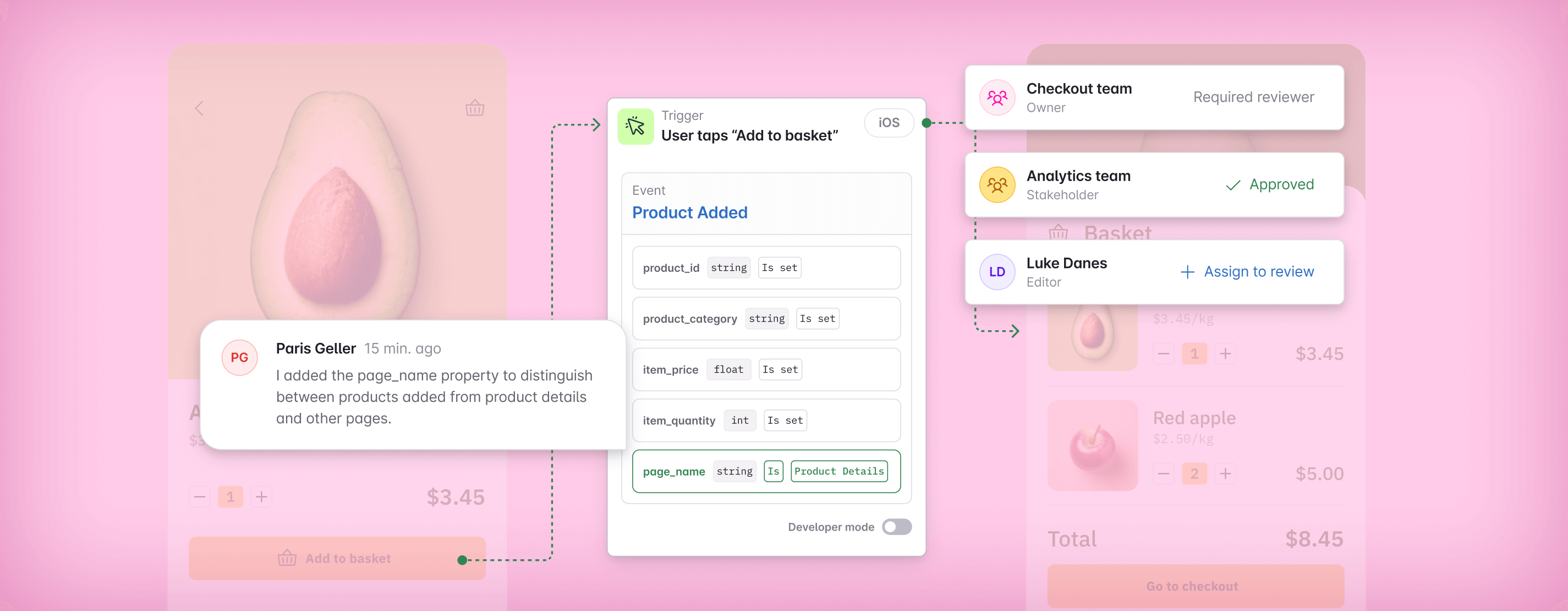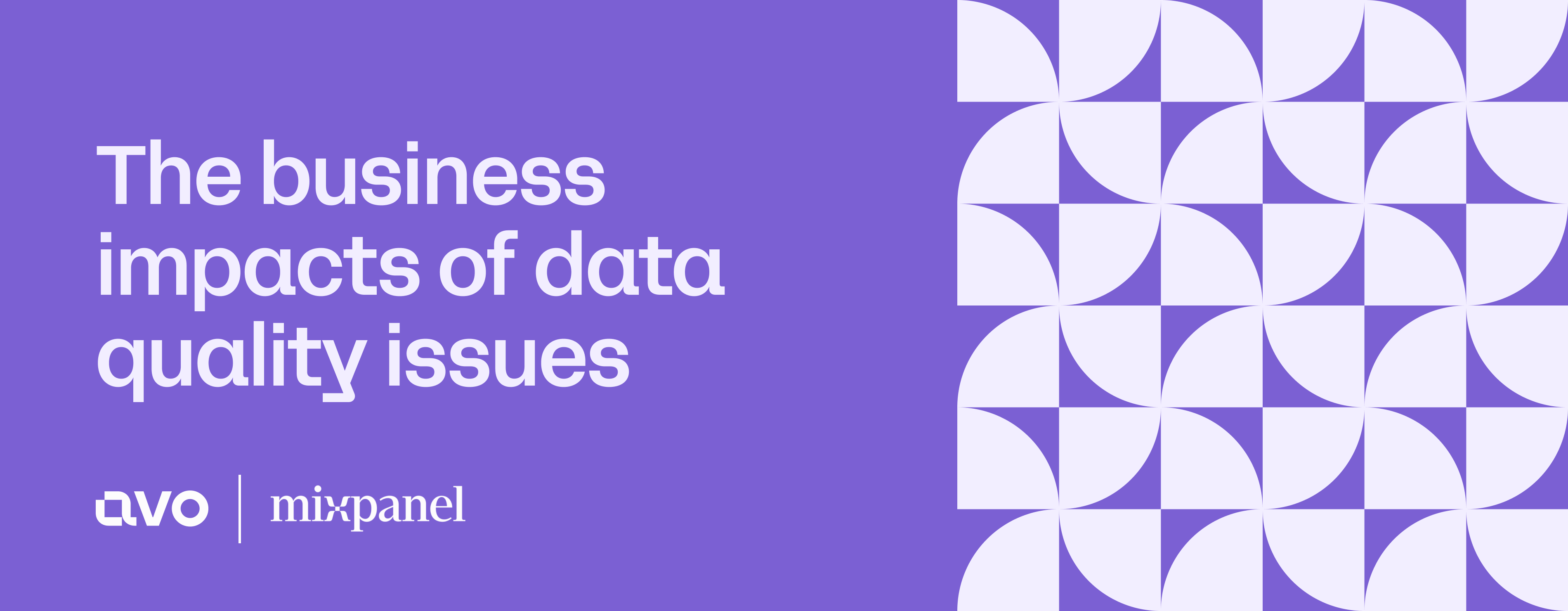In this article

Introducing Guardrails: Codify standards for data design
Data leaders shouldn’t be human spellcheckers. That’s why we’re launching tools to support anyone in designing consistent, high quality data
Why we’re launching this: Read How to do the scary thing and trust others to create great data
We at Avo strongly believe that analytics should be a cross-functional effort. And we’ve seen many companies find great success in democratizing their data culture, with product teams becoming increasingly engaged in defining their tracking needs, and leveraging self-serve analytics tools to gain insights.
However, even within organizations with very mature data cultures, defining the actual events and properties needed for these insights is still a specialized task— relying on a handful of experts to define or at least review even the smallest analytics changes.
That’s because until now, data practitioners have been the only ones with the know-how to ensure consistency and accuracy when designing new events—making themselves a bottleneck in the process. We call this the data governance dilemma.
In turn, domain owners tend to bypass these bottlenecks, thereby creating sub-standard data and sacrificing longer-term data quality for short-term wins. So we’re very excited about new solutions in Avo that unlock data design to anyone in the business.
Like one of our design partners said:
I hate having processes for things that should be software. You should be able to systemize your data design standards and effectively enforce a ”design system” for your event data.
With Data Design Guardrails and automated audits for any changes to your Tracking Plan, anyone can design data that meets the highest standards for consistency and accuracy—and they can do so in seconds.
Read: Why your event data needs a design system
Event name Guardrails: Like Grammarly for data design
With Event Name Guardrails, domain owners can effortlessly define analytics events that adhere to the correct naming convention. Avo enforces data design rules according to your specifications and so you can trust anyone in the business to create great data from the get go.

With the advanced Event Naming Guardrails we just launched, data leaders can define and enforce the event naming framework of their organization to ensure consistent event names from anyone in the company. This includes:
- Adhering to custom casing
- Following correct word order
- Following predefined values
- Avoiding event name synonyms (coming soon)

This means domain owners are free to run with their own data. With Guardrails in place, there’s no need to worry about going off script or creating inconsistent data when teams are trying to move quickly. With automated systems in place to prevent the creation of inconsistent data, the design review process should now be a breeze.
For data leaders: Enforce data design and avoid tedious reviews
Data leaders shouldn’t be human spellcheckers, they should be spending their time using their expertise on the stuff that matters—providing insights and enabling better decision making.
From the perspective of a data leader, Guardrails grants you the power to enforce consistency and quality across the company. But instead of having to review countless new events, Guardrails will do the hard work for you. Simply calibrate your design system preferences and let Avo handle the rest.
I hate to constantly have to tell someone they made a mistake. It doesn't give them a very good experience. So it’s great to have all these automatic safeguards to prevent them from getting things wrong. There is such a variation in skill level that the more we can block down, the easier it is for them to feel comfortable.
– Ursula Llaveria, Senior Data Warehouse Engineer at Bill
With Guardrails, we’re aiming to make data creation a more streamlined, less painful experience. Including:
- Less time playing data “bad cop” on inconsistent events
- Avoiding too similar or duplicate events
- A more complete picture analysis without broken data
- Reduced infrastructure costs through consolidating events
So how does it work? Set advanced event name rules and let Avo enforce them
Whether it’s Title Case, UPPER CASE, camelCase, or otherwise, you get to set the naming conventions for your event data that your team must follow. We even support custom casing if you have a very specific casing convention.
Configure an Action Object framework (Order Product) or Object Action (Product Ordered), or even set custom rules according to how you want your data to look.

When configuring your framework, the event name is broken down into its components and you can define and enforce rules for each component. So for each component you can either block certain words or specify a list of words that are allowed. This ensures that all users adhere to the same glossary when defining events and prevents creation of duplicate events for the same user actions.

While ensuring data quality standards is not yet a case of “set and forget”, we’re excited for how much time and effort Guardrails will save for data leaders.
Take Guardrails for a spin and let us know how you find it. We’re already thinking up ways to make data creation a slicker, more streamlined experience for everyone involved.
Help us shape what’s next for Guardrails
We’ll be expanding the functionality of Guardrails that will go even further to protect your data integrity.
Here are some of the things that get us excited:
- Synonym checks for events, properties and property values – preventing people from creating a new event or property when there’s an existing one they can use – to a greater extent than we currently do. Tracking plan bloat. Because right now we flag very close similarities but we don’t catch synonyms.
- Preventing events from being introduced without having an explicit owner – the audit will flag if you didn’t assign an owner to an event so there are no orphans that slip between the track
- Configurable rules that new events need to follow, such as including at least one trigger.
We can’t wait to bring the speed, accuracy, and peace of mind that Guardrails offers to your entire tracking plan, and empower everyone to run with great data. Let us know what you think is most impactful as we continue to develop Guardrails.
Stay tuned for Protected Core Data Structures
I’m also excited to mention another initiative we’re working on: The ability to protect the data structures you want to govern more tightly. This will give central governance teams a way to ensure their most critical events and properties cannot be disrupted by unwanted edits.
For instance, we’ll be adding Edit Permissions to let teams define who should/should not be able to make changes to particular data structures and make it clear who should be involved in design reviews for certain events and properties.
If you’re as excited as we are about these new developments in Avo that unlock flawless data design at scale, why not take Avo for a spin? Launching a new Avo workspace is fast, easy and free.
Try Guardrails for yourself. Launching an Avo workspace takes seconds.
—
Special thank you to Qiaoran Abbate, Jessica DeLuca, and Giorgio Terreni for their thoughtful contributions to this post.
Block Quote

